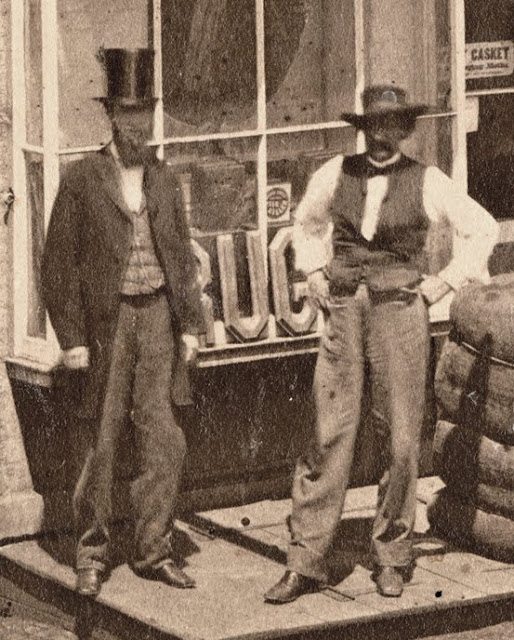I first came across this astonishing photo of West 26th street and Eleventh Avenue on Shorpy but it's originally from the George Grantham Bain Collection of the Library of Congress. This is probably one of the richest images I've ever seen—it verges on the surreal in its disparate simultaneities. Surely GG Bain didnt see, at the time of clicking the shutter, all the separate stories he was recording.
Journeying around the image—something I think of as the Ken Burns method— its fascinating to see the details of that moment. [NOTE 7-18: I shouldn't be surprised there's a Wikipedia entry about the "Ken Burns Effect"— I just cant believe I didnt know about it or the Apple reference.]
There's the coal bin on the front of the train engine, the man making his way on crutches, the spindly "ice" cart. From the camera's vantage point (and ours) the young boys and chalk drawings on the sidewalk could have been captured by Kertesz. Notice the "flagman" riding in front of the train—here a barrel cart has gotten in between. Boys on horseback, called "West Side cowboys," had to carry a red flag to warn of the approach, at six miles an hour, of each locomotive.
There's the coal bin on the front of the train engine, the man making his way on crutches, the spindly "ice" cart. From the camera's vantage point (and ours) the young boys and chalk drawings on the sidewalk could have been captured by Kertesz. Notice the "flagman" riding in front of the train—here a barrel cart has gotten in between. Boys on horseback, called "West Side cowboys," had to carry a red flag to warn of the approach, at six miles an hour, of each locomotive.
New York Central's freight line had run along Tenth and Eleventh Avenues since 1849. Known as "Death Avenue" for the number of pedestrians killed by the mix of railroad and street life, the name was used collectively for both streets. Statistics vary; one study recorded 21 deaths on Tenth and Eleventh from July of 1907 to July of 1910. Somehow the flagmen didnt seem to make walking along the avenue much safer. A New York Times notice from November, 1911, about the year of this photo, announced:
"Another 'Death Avenue' suit was filed yesterday [by the brother of the victim]... Cyrus J Burby was crossing Tenth Avenue, the complaint states, when his foot became wedged between the track and the sidewalk. Before he could extricate himself a train bore down on him without warning and he was decapitated."
In 1929 the City and State of New York and the New York Central Railroad agreed on the West Side Improvement Project, which would replace "Death Avenue" with a seemingly futuristic elevated line that entered warehouses on their upper floors.
By 1931 the entire block in this image— the west side of Eleventh Avenue, 26th to 27th streets— had become the magnificent Starrett-Lehigh Building. The Lehigh Valley railroad had retained the ground floor as a vast freight yard, and the 19-story, 1.8 million-square-foot building, with its three gigantic elevators to lift and lower trucks, was put up directly above it. (Today the axle grease has been wiped away and Comme des Garcons, Hugo Boss, and Martha Stewart are among the tenants)
The High Line, as the new elevated freight line was called, opened to trains in 1934 and was used until the early 1980s. Saved from demolition by a grassroots movement in the early 2000s, a portion of the High Line is now a park that is so exquisite, so unbelievably well done, it's hard to believe it got built in New York. In my opinion, it is one of the triumphs of this city.




















